Neon Art: A Glowing Journey Through Modern Creativity
Author:
GeorgeUpdated:
01.02.2025
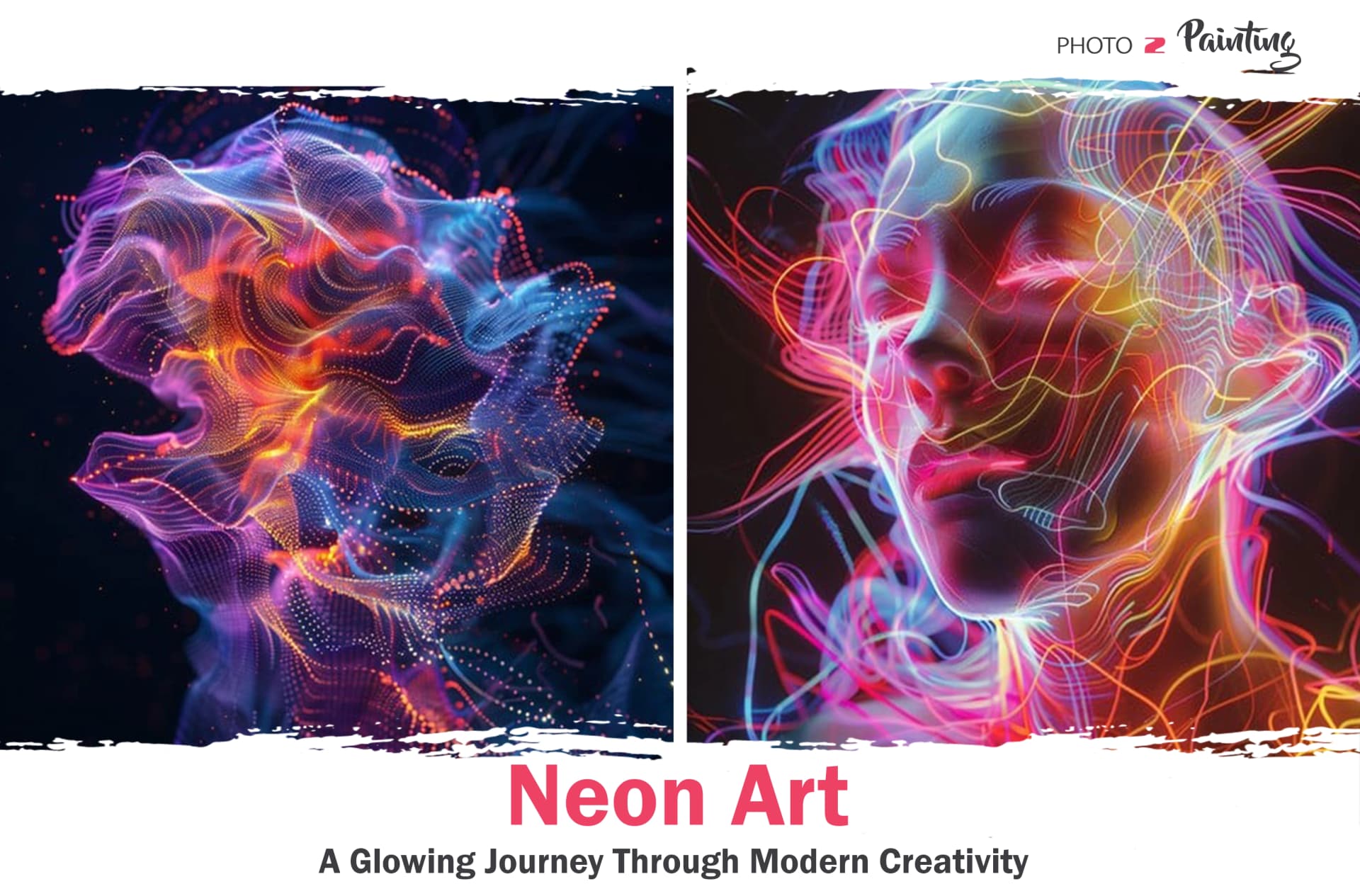

- Key Takeaways
- What is Neon Art?
- 1.Origins of Neon as a Material
- 2.From Signage to Art
- 1.
- The Evolution of Neon Art
- 3.Mid-20th Century: Neon Becomes Art
- 4.1960s–1970s: Neon and New Art Movements
- 5.Modern Times: New Ideas and Technology
- 3.
- Characteristics of Neon Art
- 6.The Medium: Neon Tubes and Colors
- 7.The Craft: Challenges of the Neon Art
- 8.The Themes in Neon Art
- 6.
- Iconic Neon Artists and Their Works
- 9.Bruce Nauman: The True Artist Helps the World by Revealing Mystic Truths (1967)
- 10.Joseph Kosuth: Five Words in Orange Neon (1965)
- 11.Tracey Emin: You Loved Me Like a Distant Star (2012)
- 12.Dan Flavin: Untitled (To You, Heiner, With Admiration and Affection) (1973)
- 13.Jung Lee: I Want to Be Your Love (2012)
- 14.Glenn Ligon: Warm Broad Glow II
- 15.Keith Sonnier: Ba-O-Ba
- 16.Olafur Eliasson: Your Uncertain Shadow (Neon Edition)
- 9.
- Neon Art in Modern Culture
- 17.Intersection with Digital Culture and Social Media Aesthetics
- 18.Neon in Public Installations, Galleries, and Pop-Up Exhibitions
- 19.Reflecting Urban, Cultural, and Environmental Themes
- 17.
There’s always been something mesmerizing about neon art. It catches your eye with glowing and strong colors. That’s why it’s so commonly used on signs that brighten city streets. Also, you might have seen neon art used to add colorful accents in modern homes.
Neon colors transform ordinary spaces into something unique and eccentric. Actually, bright colors are scientifically known to be visually stimulating and energizing. They can help combat feelings of fatigue and lethargy.
As artist Glenn Ligon said,
“Neon provides a powerful and immediate way to convey language and ideas, transforming words into luminous objects.”
Neon art started with neon lights, first invented by Georges Claude in 1910. At first, neon was mostly used for advertising, but its bold glow quickly became a symbol of city life and energy. Over time, artists began using neon to create amazing designs and artwork. Now, neon art is found in galleries, museums, and public spaces all around the world. This shows how neon has grown from business signs into a popular form of art.
Key Takeaways
Neon began as a tool for advertising but evolved into a celebrated art form.
Neon art is made by heating glass tubes to shape them, filling the tubes with gases like neon or argon, and adding electricity to make them glow.
Neon art reflects the energy of urban life and the evolving styles of different area and it's shown in the neon signs of Times Square, Las Vegas and modern galleries.
Neon art explores a wide range of themes, including identity, love, social commentary, and abstract design.
Visionary artists like Bruce Nauman (The True Artist Helps the World by Revealing Mystic Truths), Tracey Emin (You Loved Me Like a Distant Star), and Glenn Ligon (Warm Broad Glow II) have pushed the boundaries of neon art, turning light into a medium for profound expression.
Neon art is seen in public installations, galleries, and social media.
What is Neon Art?
Neon art is a type of artwork that uses neon lights to create glowing, colorful designs. Artists shape glass tubes into words, images, or abstract patterns, then fill them with neon or other gases that emit light when electrified. These artworks can be recognized for bright colors and ability to draw attention. It makes them exciting and unique.
Neon art isn’t just about glowing lights—it’s about expressing emotions, ideas, and creativity in a way that feels alive. Studies have shown that different colors can evoke various feelings in people. For example, red and orange can create feelings of energy and excitement, while blue and green often evoke calmness and relaxation. Neon art uses this power of color to connect with viewers on an emotional level.
Neon art turns light into a powerful form of expression, from simple signs with inspiring words to detailed images that light up entire rooms. If you're inspired to create your own vibrant designs, you might want to explore types of painting styles to understand how neon fits into the broader art world.
Origins of Neon as a Material
Neon gas was first discovered in 1898 by scientists Sir William Ramsay and Morris Travers. It wasn’t until 1910, though, that a French inventor named Georges Claude created the first neon light. Neon quickly became popular for its ability to glow brightly, even in the dark.
In the 1920s and 1930s, neon signs became a major part of cityscapes around the world, lighting up streets with glowing advertisements for stores, theaters, and restaurants. The famous neon signs of Times Square in New York City and the Las Vegas Strip are examples of how neon became a symbol of excitement and energy. Neon art, much like landscape painting, often takes inspiration from urban and natural environments alike.
From Signage to Art
At first, neon was mostly used for practical purposes like advertising, beginning in 1912 with a Parisian barber shop that used neon lights to attract attention. However, artists soon realized its creative potential, transforming neon into a medium for expression. In the 1960s, neon art began to take off as artists started bending neon tubes into unique shapes and using light to express their ideas. Artists like Bruce Nauman and Tracey Emin transformed neon from a material for business signs into an art form that explored deeper emotions and concepts.
Today, neon art is seen in galleries, museums, and public spaces. Modern artists use neon to explore themes like identity, love, and human connection. It’s also used in abstract ways, with glowing colors and shapes that inspire wonder and creativity. With advancements in technology, some neon art now blends traditional neon with LED lighting or digital effects, making it even more versatile and innovative.
For a deeper look at artistic evolution, explore how traditional art has also influenced modern expressions like neon art.
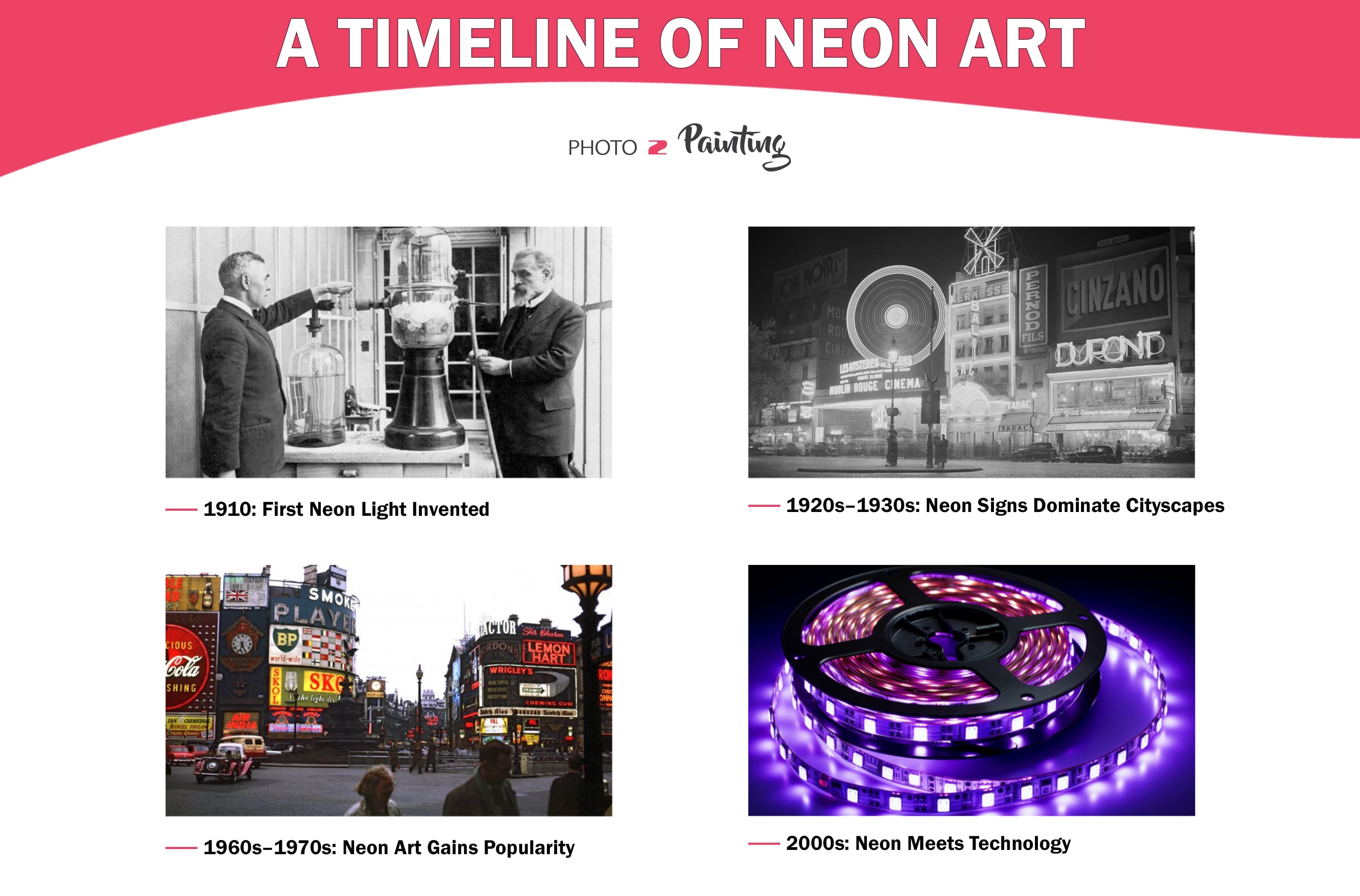
The Evolution of Neon Art
Neon art didn’t become famous as an art form right away. It started as a tool for advertising and slowly transformed into a way for artists to express ideas and emotions. Over time, neon art has reflected the trends and styles of each era. It is growing into a popular and creative medium. Modern artists use neon to explore personal themes like identity, emotions, and connections with others. Many artists mix traditional neon techniques with new technologies, like LED lights or digital effects, to create unique and exciting works. These innovations have enabled neon to embrace diverse artistic styles. From bold, abstract pieces to works reminiscent of surrealist paintings, it challenges perceptions and blurs reality with dreamlike elements.
Let’s look at how neon art has changed over the years.
Mid-20th Century: Neon Becomes Art
In the middle of the 20th century, some artists started to use neon lights in creative ways. Joseph Kosuth was one of the first to use neon to explore big ideas. In his work “Five Words in Orange Neon,” he used glowing words to make people think about the meaning of language and art.
Another important artist, Bruce Nauman, used neon in a playful and thought-provoking way. His artwork “The True Artist Helps the World by Revealing Mystic Truths” combined words and light to challenge viewers to think about what art really means. This time period marked the beginning of neon’s shift from being used in advertising to becoming a respected art form.
1960s–1970s: Neon and New Art Movements
In the 1960s and 1970s, neon art became more popular as part of conceptual and minimalist art movements. These styles focused on simple designs and powerful ideas, and neon’s clean lines and bright light fit perfectly. Many artists used neon to create bold text-based works that grabbed attention and made people think.
During this time, neon was also influenced by pop culture. The glowing lights of cities like Las Vegas and New York’s Times Square became symbols of energy and excitement. Artists used neon to reflect this fast-paced culture while also bringing it into art galleries. Neon was both fun and meaningful. It bridges the gap between commercial signs and fine art.
Modern Times: New Ideas and Technology
Today, neon art continues to grow and change. Modern artists use neon to explore personal themes like identity, emotions, and connections with others. Many artists mix traditional neon techniques with new technologies, like LED lights or digital effects, to create unique and exciting works.
Neon art can now be found in galleries, public spaces, and even private homes. It has also become a popular part of fashion, interior design, and social media. Neon’s bright, glowing colors and creative designs make it a symbol of modern creativity and innovation.
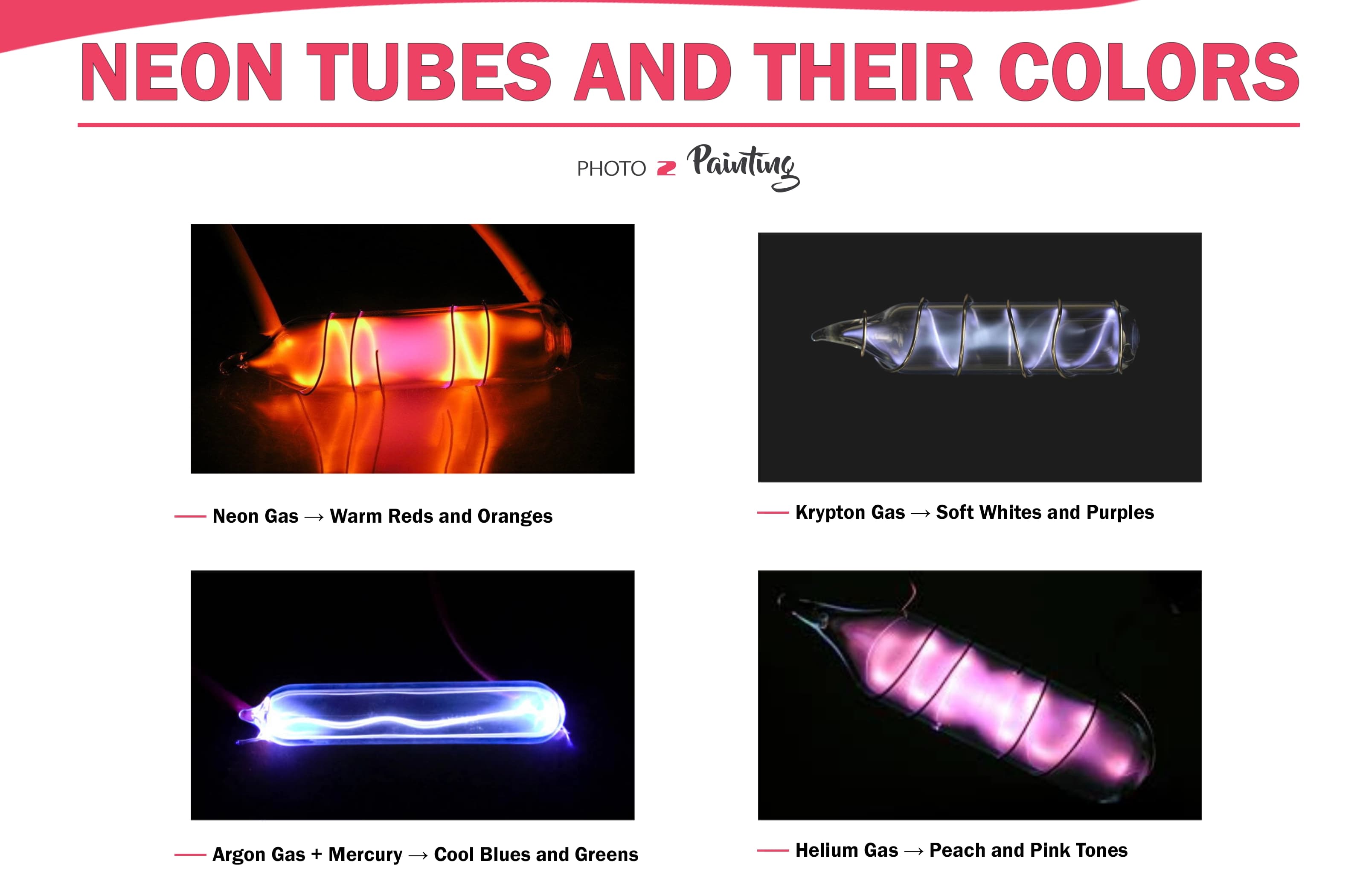
Characteristics of Neon Art
Neon art is a unique art form that combines the beauty of glowing light with the precision of craftsmanship and the power of artistic expression. Known for its vibrant colors and captivating energy, neon art stands out as a fascinating mix of science, skill, and creativity. Let’s explore what makes neon art so special. This interplay of light and color makes neon captivating, similar to the visual harmony you’ll find in acrylic painting ideas.
The Medium: Neon Tubes and Colors
At the heart of neon art is its distinctive medium—glass tubes filled with gases like neon or argon. When electricity passes through these gases, they emit a radiant glow. The type of gas and any added phosphor coating determines the colors:
- Neon gas produces warm reds and oranges.
- Argon gas, often mixed with mercury, creates cool blues and greens.
This scientific process transforms simple materials into glowing works of art. Much like how different painting mediums, such as oil, acrylic, or watercolor, shape the look and feel of traditional artworks.
Neon’s interplay of light and color makes it especially captivating, creating a sense of energy and motion even in still designs. The glowing, otherworldly effect is what gives neon art its signature look.
The Craft: Challenges of the Neon Art
Making neon art is a skill that requires technical expertise and artistic creativity. Artists heat glass tubes over flames, bending them into shapes or letters—a task that demands precision and patience to prevent the fragile glass from breaking. After shaping the tubes, they are filled with gas. It is sealed and connected to an electrical current to create the glow.
Even small mistakes can impact the final result, so the process requires careful attention at every step. The blend of science and artistry involved in creating neon makes each piece one of a kind. This craftsmanship ensures that neon art isn’t just visually striking—it’s a testament to the artist’s dedication and skill.
The Themes in Neon Art
Neon art often reflects the artist’s vision through a wide range of themes.
Text-Based Works
Many neon artworks use glowing words or phrases to create strong visual and emotional impacts. Artists like Tracey Emin turn personal emotions into neon narratives, while others use text to explore social and cultural issues.
Abstract and Geometric Designs
Some neon art focuses on shapes and colors, using light to evoke emotions or challenge perceptions. Abstract neon pieces, often inspired by geometric art, can be playful, thought-provoking, or purely aesthetic.
Social Commentary
Neon’s glowing presence is also a tool for protest and reflection. Artists use it to highlight issues, spark conversations, or challenge conventional ideas, blending light with powerful messages.
Whether it’s a single glowing word, a complex design, or a bold statement, neon art transforms light into a medium for storytelling and self-expression.
Iconic Neon Artists and Their Works
Neon art has been elevated by visionary artists who transformed this glowing medium into a powerful form of expression. Each artist has brought their unique perspective. They are using neon to explore themes of language, emotion, and identity. These standout works demonstrate how neon can inspire, challenge, and connect with viewers. They are turning light into unforgettable art. Let’s take a closer look at some of the most iconic artists and their groundbreaking pieces.
Bruce Nauman: The True Artist Helps the World by Revealing Mystic Truths (1967)
Bruce Nauman’s The True Artist Helps the World by Revealing Mystic Truths is a main work in conceptual art. This piece features a spiral of neon light with the titular phrase written in glowing cursive. While the phrase might seem like a bold declaration, Nauman layers it with irony, prompting viewers to question the role of the artist. Are they truly mystical visionaries, or is the statement a playful exaggeration?
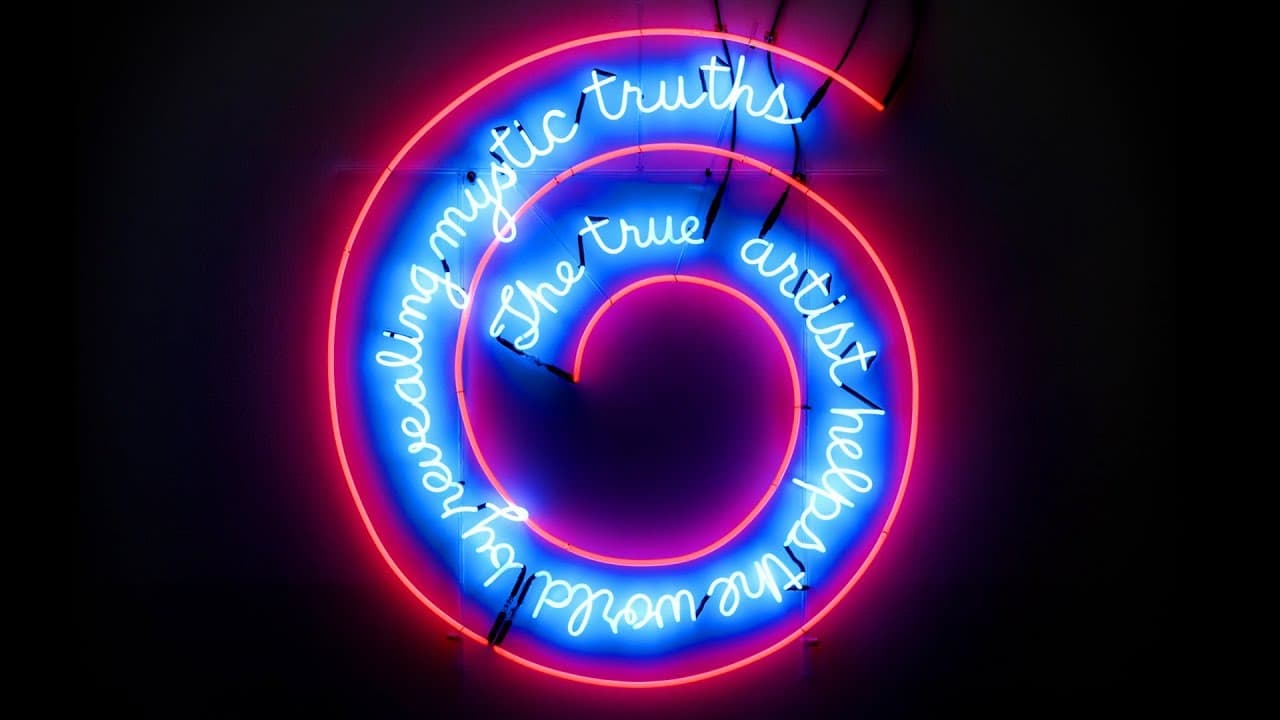
The glowing spiral also mirrors the cyclical nature of artistic thought. It draws viewers into its loop of meaning and self-reflection. By turning text into a visual experience, Nauman elevated neon beyond its functional roots. He made it a medium for philosophical exploration.
Joseph Kosuth: Five Words in Orange Neon (1965)
Joseph Kosuth’s minimalist Five Words in Orange Neon exemplifies his focus on language and meaning. This artwork, consisting of five glowing words, challenges viewers to see language not just as a tool for communication but as a subject for deeper thought.
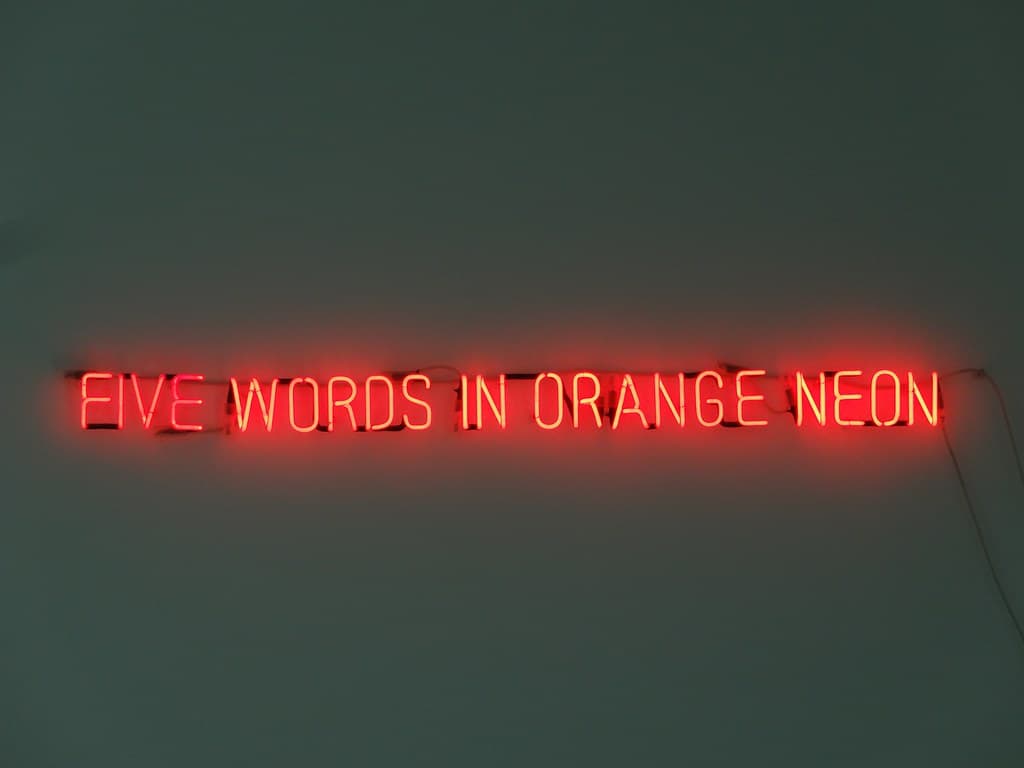
Kosuth wanted to show how context changes the way we interpret words, turning something seemingly simple into a complex idea. Neon’s radiant glow enhances the impact, creating a striking juxtaposition between the material (glass tubes) and the immaterial (language). This work marked a turning point in conceptual art, with Kosuth using neon to bridge the gap between thought and form.
Tracey Emin: You Loved Me Like a Distant Star (2012)
Tracey Emin’s You Loved Me Like a Distant Star is a deeply personal neon piece that captures her signature storytelling style. The artwork features glowing text in Emin’s handwriting, expressing themes of longing and heartbreak. The phrase feels intimate, yet its glowing neon light transforms it into a universal statement about love and distance.
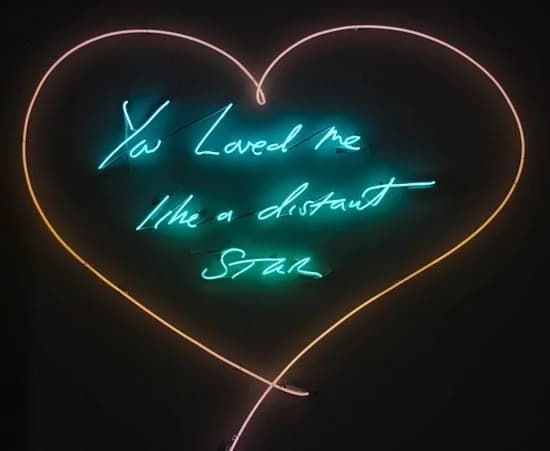
The soft blue and pink hues of the neon evoke vulnerability and warmth. It draws viewers into Emin’s emotional world. By using neon, she turns her personal narrative into a visual experience that resonates with anyone who has experienced love and loss. This piece perfectly aligns with the themes found in romantic paintings, blending emotional depth with artistic beauty.
Dan Flavin: Untitled (To You, Heiner, With Admiration and Affection) (1973)
Although Dan Flavin worked with fluorescent lights rather than traditional neon, his contributions to light art are undeniable. Untitled (To You, Heiner, With Admiration and Affection) is a tribute to Flavin’s friend Heiner Friedrich and showcases his minimalist approach to light.
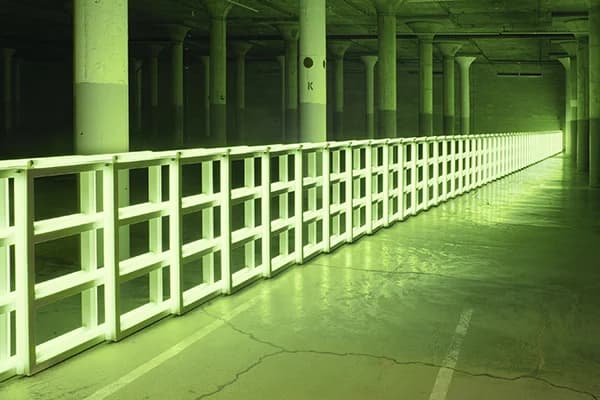
This installation uses fluorescent light tubes arranged in geometric patterns, bathing the space in vibrant colors. Flavin’s work invites viewers to consider how light interacts with space and changes perception. While not strictly neon, his focus on the transformative power of light has had a lasting influence on the world of neon art.
Jung Lee: I Want to Be Your Love (2012)
Jung Lee’s I Want to Be Your Love combines neon with nature. It creates a haunting and poetic visual experience. The piece features glowing neon text placed in an outdoor, foggy landscape. The stark contrast between the artificial light and the natural environment evokes feelings of longing and isolation.
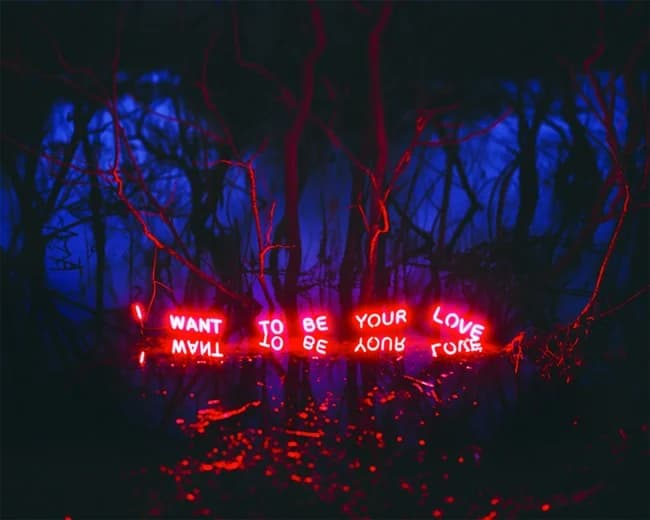
What might seem like a romantic message takes on a melancholic tone in its desolate setting. It explores the tension between human emotion and modern technology. Lee’s work demonstrates how neon can transcend its traditional settings, bringing powerful messages to unexpected places.
Glenn Ligon: Warm Broad Glow II
In Warm Broad Glow II (2011), Glenn Ligon uses neon text to explore important themes like race, identity, and history. The piece features the phrase “negro sunshine,” a line borrowed from author Gertrude Stein. However, part of the text is deliberately obscured, making it difficult to read. This creates a sense of tension between what is visible and what is hidden. It forces viewers to think about the things in society that are often overlooked or left unsaid.
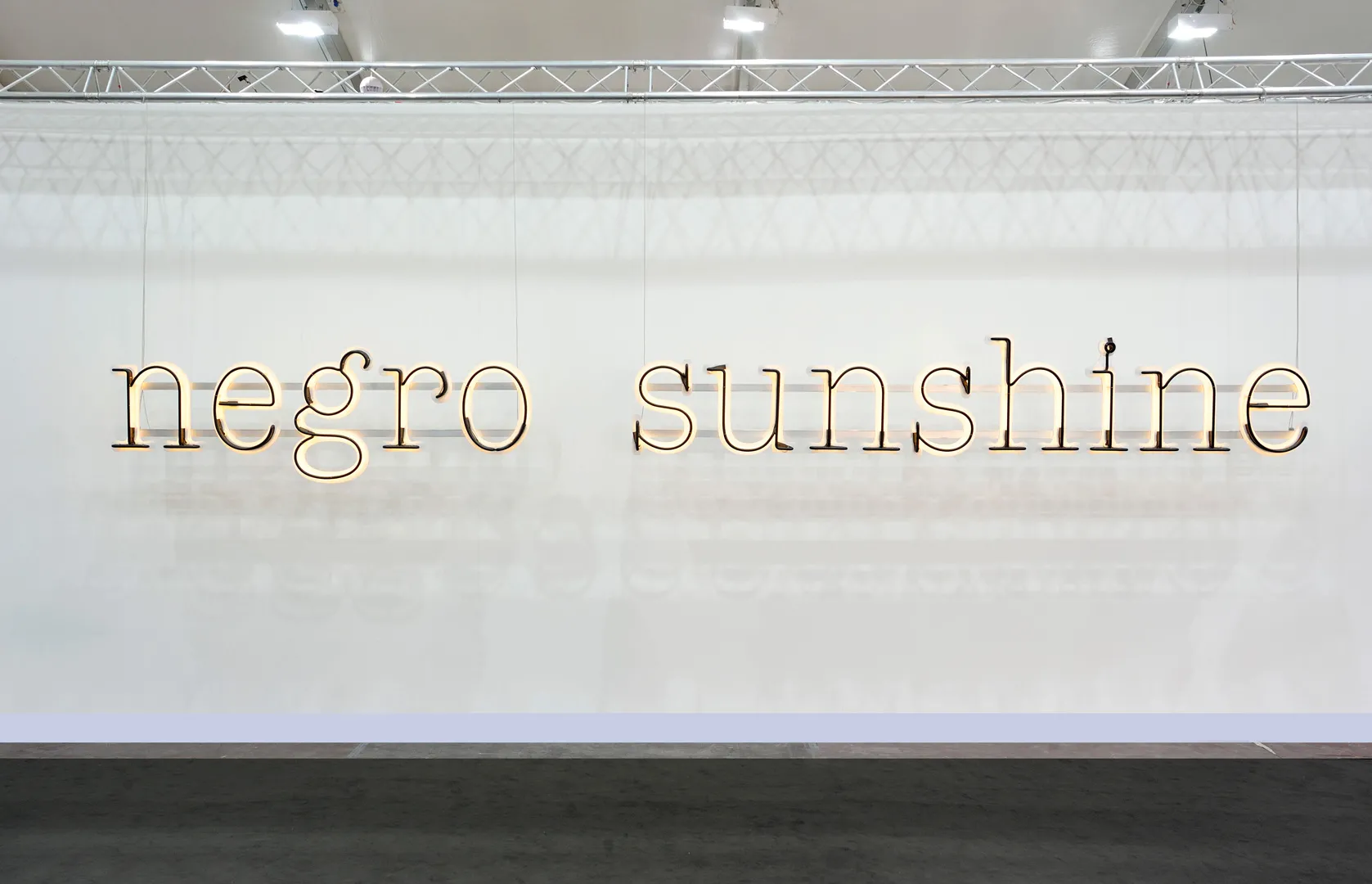
By using neon’s bright, glowing light, Ligon draws attention to stories and histories that are sometimes forgotten. It makes his work both beautiful and thought-provoking like spiritual art.
Keith Sonnier: Ba-O-Ba
Keith Sonnier’s Ba-O-Ba series (1969) is a collection of sculptures that combines neon with materials like aluminum and glass. These pieces don’t just sit still—they transform the space around them with their glowing, curved neon tubes. The bright colors and abstract shapes create a dynamic energy which makes the room feel alive.
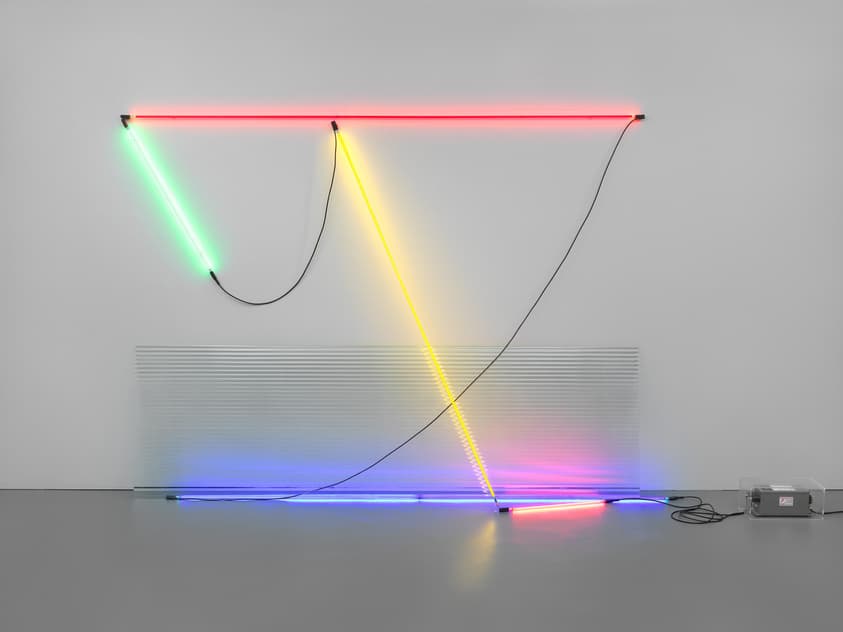
Sonnier’s work challenges the idea that art has to be traditional, like paintings or statues. Instead, he shows how neon can be used to create exciting, modern sculptures. His ability to mix neon with other materials demonstrates how versatile and innovative the medium can be.
Olafur Eliasson: Your Uncertain Shadow (Neon Edition)
Olafur Eliasson’s Your Uncertain Shadow (Neon Edition) (2010) invites viewers to interact directly with the art. The piece uses colorful neon lights to cast shifting shadows on the walls. It creates a playful and ever-changing display. As people move around the installation, their shadows blend with the colors, making them a part of the artwork.
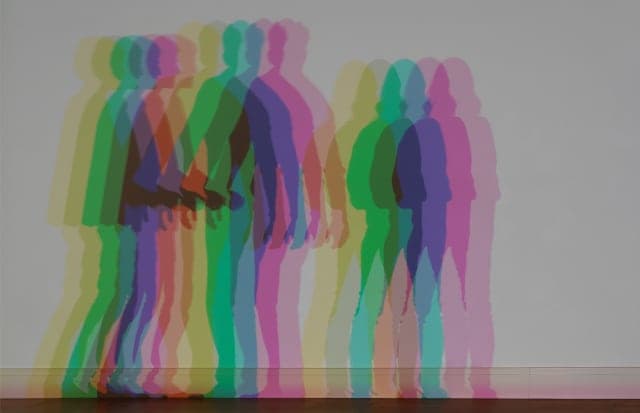
Eliasson’s work combines art, science, and fun, showing how neon can go beyond being just something to look at. It becomes an experience that connects people to the space around them in a new and exciting way.
These iconic artists have pushed the boundaries of neon art, transforming it from a practical medium into a tool for profound expression. Through their works, they have shown how neon’s glowing light can explore themes of identity, emotion, and meaning. It inspires audiences around the world. Whether playful, poetic, or provocative, neon art continues to captivate and challenge, proving that even light can carry deep artistic significance.
Neon Art in Modern Culture
Neon art has become an important part of modern culture. Its bright, glowing lights represent creativity, energy, and self-expression. Today, neon can be found in cities, galleries, and even on social media. It is a unique way to connect with people.
Intersection with Digital Culture and Social Media Aesthetics
In the digital age, neon art has found a new home on social media. Its bold colors and glowing designs make it perfect for platforms like Instagram, where eye-catching visuals are popular. Neon art installations, especially those with powerful phrases or creative shapes, often go viral and inspire people around the world.
Neon isn’t just popular for sharing photos—it has also influenced digital design. Neon-style visuals are common in video games, virtual art, and even online advertisements. Its glowing, futuristic look blends traditional art with modern technology, creating a style that feels fresh and exciting.
Neon in Public Installations, Galleries, and Pop-Up Exhibitions
Neon art has also become a favorite for public art installations, where its vibrant light turns city spaces into glowing art experiences. Cities like Los Angeles, London, and Tokyo host festivals and events where neon art takes center stage. Neon lights in public spaces bring energy to urban areas, creating interactive and memorable experiences for everyone.
Museums and galleries are also important in keeping neon art alive. The Neon Museum in Las Vegas and the Museum of Neon Art in California celebrate the history of neon and how it has evolved into an art style. Famous museums like the Tate Modern in London have displayed neon works by artists like Bruce Nauman and Tracey Emin.
Pop-up exhibits and temporary shows also play a big role in neon’s popularity. Exhibitions like “Illuminated: The Art of Neon” at the Akron Art Museum or neon art at Art Basel create exciting environments where visitors can experience neon up close. These events show how neon art can be playful, immersive, and inspiring in different spaces.
Reflecting Urban, Cultural, and Environmental Themes
Neon art has always been tied to the energy of city life. Its glowing presence reflects the hustle and bustle of urban areas and the diversity of people living in them. Artists often use neon to explore social issues like identity, consumerism, and inequality. For example, Glenn Ligon creates glowing neon phrases that make viewers think about race and culture, while Jung Lee uses neon to explore emotions like love and loneliness.
In addition to city life, some neon art focuses on humanity’s connection with nature. For example, Jeppe Hein uses neon to explore mindfulness and inner peace, blending the fast-paced glow of neon with calming messages. Neon art has become a tool for reflecting both the challenges and the beauty of modern life.
Conclusion
Neon art has become a powerful and enduring medium, blending light, color, and creativity to reflect the energy and complexity of modern culture. From its early days as a tool for advertising to its celebrated status in galleries, public installations, and digital spaces, neon art has transformed how we experience light and design.
As Tracey Emin said,
“Neon allows me to give voice to the unseen, to illuminate the hidden emotions that lie beneath the surface.”
This ability to bring emotion and meaning to light is what makes neon art so captivating and timeless.
As we look to the future, neon art will continue to evolve, incorporating new technologies like LED lighting and digital effects. Artists will push creative boundaries. They are using neon to explore themes of identity, social change, and environmental awareness in innovative and immersive ways. Its unique ability to brighten spaces while expressing powerful ideas ensures that neon art will remain a vital and inspiring force in the art world.
In our fast-paced and often chaotic lives, neon art serves as a beacon. It illuminates the beauty of creativity and the power of bold expression. Its glowing presence will continue to captivate and inspire, lighting the way for future generations of artists and audiences alike.
Frequently Asked Questions
Why is neon so popular?
Neon is popular because its bright, glowing colors grab attention and create a fun, exciting, and modern vibe. It is often used in art, advertising, and design because it stands out and evokes both nostalgia and creativity.
How do you paint neon pictures?
To paint neon pictures, you use fluorescent or neon paints that reflect light, making the colors appear bright and glowing. These paints work best over a white base layer, which enhances their vibrancy and gives the illusion of a neon effect.
How do you make acrylic paint look neon?
You can make acrylic paint look neon by mixing it with fluorescent pigments or purchasing pre-made neon acrylics. Applying the paint over a bright white base and layering the colors can help achieve the intense, glowing effect often associated with neon art.
Why are neon lights so expensive?
Neon lights are expensive because they are handmade by skilled artisans who bend glass tubes into specific shapes and fill them with rare gases like neon or argon. The process is time-consuming, and the materials, including the transformers needed for power, add to the cost.
Which neon color is the brightest?
Green is typically the brightest neon color because the human eye is most sensitive to green light. It stands out more vividly compared to other neon colors, making it the most noticeable in both natural and artificial lighting.
George, CEO of Photo2painting, is a passionate art lover and entrepreneur. He founded Photo2painting.com from scratch, inspired by his artist friends. As the company's CMO, he manages content and marketing.
Excellent Customer Reviews















































































































































